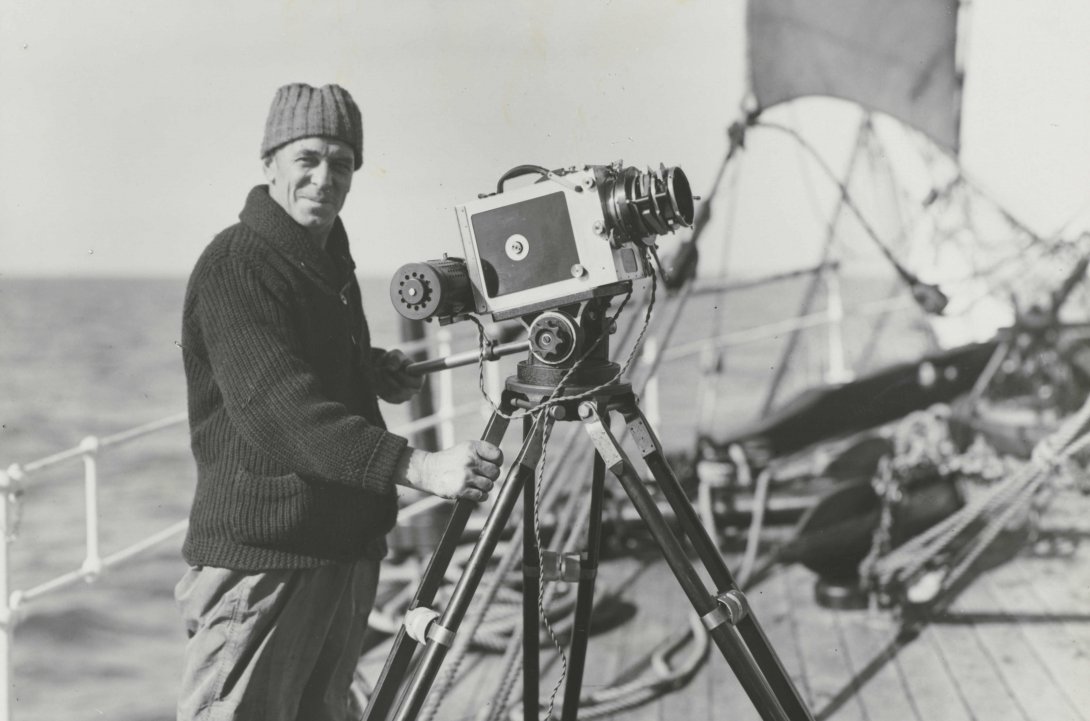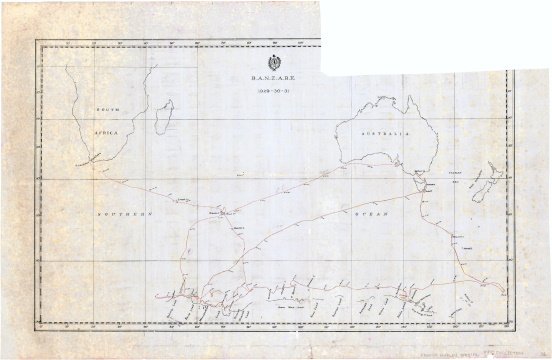James Francis Hurley (1885–1962) was born in Sydney and educated at Glebe Public School. At the age of 13 he ran away from school and worked in a steel mill at Lithgow. In 1900 he returned to Sydney. He became interested in photography and in 1905 joined Harry Cave in a postcard business. He quickly established a reputation for the high technical quality of his work and for his willingness to take risks in order to obtain spectacular images. He held his first exhibition in 1910.
In 1911 Hurley joined the Australasian Antarctic Expedition, led by Douglas Mawson, as the official photographer. He took both still photographs and movie film and on his return to Australia in 1913 he produced the film Home of the Blizzard. In 1914 he joined the Antarctic expedition led by Sir Ernest Shackleton and took his most famous photographs, showing the ship Endurance being gradually crushed in the pack-ice. He completed his film In the Grip of Polar Ice in 1917. In the same year he joined the Australian Imperial Forces as official photographer and served in both France and the Middle East, where he photographed the Light Horse capturing Jericho. In 1920–23 he made two long filming expeditions to the Torres Strait Islands and Papua, resulting in a film and a book, Pearls and Savages. In 1929 he returned to the Antarctic with Mawson and the British Australian New Zealand Antarctic Research Expedition and made two films.
Hurley, Captain Frank Hurley with a camera on board the Discovery, 1931, nla.obj-141179873In the 1930s Hurley worked with the Cinesound studio as a cameraman and later as the head of its special documentary unit. In World War II he was again the official photographer with the Australian Imperial Forces in the Middle East. In his later years he travelled extensively in Australia, published several books of photographs, lectured and contributed articles to newspapers. He sometimes clashed with other photographers, but he always thrived as a lone adventurer, travelling to exotic places and producing films and books for Australian and British audiences. He was awarded the OBE in 1941.
Among Hurley’s many books were Pearls and Savages (1924), Argonauts of the South (1925), Shackleton’s Argonauts: A Saga of the Antarctic Ice-packs (1948), Sydney: A Camera Study (1948), Queensland: A Camera Study (1950), The Blue Mountains and Jenolan Caves: A Camera Study (1952), Western Australia: A Camera Study (1953) and Australia: A Camera Study (1959).
Acquisition
The photographs, papers, maps and books of Hurley were purchased by the Library from his wife, Antoinette Hurley, in 1963–66. The transparencies and stereoscopic views were bought from Mrs Hurley in 1975. The 1921 diary of Hurley was purchased from the Sydney booksellers Berkelouws in 1978.
Description
Photographs
The Hurley Collection contains about 1000 exhibition prints, a quantity of miscellaneous prints, several photograph albums, a group of stereographs and over 10 000 black and white negatives and colour transparencies. They date from about 1911 until Hurley’s death in 1962.
The earliest photographs were taken by Hurley during the Australasian Antarctic Expedition in 1911–13. They depict the ship Aurora, Douglas Mawson, Xavier Mertz and other members of the expedition, Macquarie Island, Adelie Land, blizzards, sea elephants, penguins and petrels. There are a small number of photographs of Java taken following Hurley’s return to Australia in 1913. The photographs of the 1914–16 Antarctic expedition include the famous images of the Endurance trapped in the pack-ice and its gradual destruction. There are also photographs of Ernest Shackleton and other members of the expedition, Elephant Island, South Georgia and fjords.
The World War I photographs include the Ypres and Passchendaele battlefields, wounded soldiers, aircraft and landscapes in northern France and Flanders. There are also photographs of the Australian Light Horse and the Imperial Camel Corps in the Middle East. Many of the Middle East photographs are not dated and it is difficult to ascertain whether they were taken during World War I or World War II.
In 1921–23 Hurley travelled to the Torres Strait Islands, Papua and New Guinea and his photographs depict the indigenous peoples, houses, villages, missions, skull racks, canoes, pearling, Wanigela, the Buna Bay district, Murray Island, Mailu Island, Moa Island and Mount Lamington.
The British Australian New Zealand Antarctic Research Expedition photographs of 1929–31 include Sir Douglas Mawson, Captain J.K. Davis and other officers and crew of the Discovery, scientists on the expedition, Kerguelen, Heard Island, MacRobertson Land, icebergs and landscapes.
The largest group of non-Australian photographs in the collection were taken by Hurley in North Africa and the Middle East in 1940–44. They cover a wide area—Libya, Sudan, Egypt, Jordan, Palestine, Syria, Lebanon, Iraq and Iran—and include such cities as Cairo, Jerusalem, Bethlehem, Tel Aviv, Nablus, Petra, Aleppo, Amman, Jericho, Damascus, Acre, Haifa, Hama, Tripoli, Luxor, Beirut and Basra. The subject matter is equally broad: Australian soldiers, gun emplacements, Arab legionnaires, Bedouin shepherds and camps, street scenes, bazaars, camel markets, churches, mosques, temples and chapels, schools, felluccas on the Nile, ancient ruins and monuments, crusader fortresses and desert landscapes.
The Australian photographs, which are mostly undated, cover the whole country. Among the many places represented, in addition to all the capital cities, are Albany, Albury, Alice Springs, Arnhem Land, Atherton Tableland, Australian Alps, Ballarat, Blue Mountains, Broken Hill, Bunbury, Burnie, Cairns, Cradle Mountain, the Dandenongs, Eaglehawk Neck, Great Barrier Reef, Hawkesbury River, Innisfail, Jenolan Caves, Kalgoorlie, Lord Howe Island, MacDonnell Ranges, Mount Gambier, Newcastle, Ord River, Rockhampton, Thursday Island, Townsville, Wagga Wagga, Warrumbungle Mountains, Wollongong and the Yarrangobilly Caves. There are many photographs of street scenes, public and commercial buildings, churches, the Sydney Harbour Bridge, city houses and country homesteads, sheep and cattle stations, canefields and sugar mills, Aboriginal settlements, country roads, beaches and coastlines, sailing boats, seascapes and rural views. The collection is strong in pictures of industrial and mining sites, such as the Port Kembla steelworks, the BHP steelworks at Newcastle, aircraft assembly plants, the Associated Smelters at Port Pirie, Yallourn coal mine and power station, Mount Lyell copper mine, Mount Morgan gold mine, Tarraleah power station, and the Kiewa and Snowy Mountains hydro-electric schemes. Finally, there are photographs of birds, butterflies, trees, coral and rock formations, and cloud formations and a number of composite photographs.
Manuscripts and Personal Papers
The main strength of the personal papers of Hurley are 29 diaries that he kept during the three Antarctic expeditions, as an official photographer in France and the Middle East in 1917–18, during the two expeditions to the Torres Strait Islands, Papua and New Guinea in 1921–23, and while serving in the Middle East and North Africa in World War II. There are also diaries that he kept on a flight from England to Australia in 1928 and on a tour around Australia in 1961. Other papers consist of several newspaper cutting books, manuscripts and typescripts of books and articles, film scripts, and passports, identification cards, press cards and other documents.
Maps
The Hurley Collection contains 33 cartographic items, mostly consisting of road and tourist maps and guides of the mainland states of Australia. They were produced by government agencies and oil companies, especially the Shell Company, in the 1950s. In addition, there is a map of Australian and New Zealand air routes (1958) and a manuscript map showing the route of the British Australian New Zealand Antarctic Research Expedition in 1929–31.
B.A.N.Z.A.R.E. 1929-30-31, Frank Hurley Map Collection, National Library of Australia, Item 32, nla.cat-vn1030382
Organisation
The exhibition prints, transparencies, stereographs, albums and other photographs are kept together as a collection in the Pictures Collection. The prints occupy 47 drawers, while the negatives are stored in 374 boxes. Nearly all the photographs have been individually catalogued and the call numbers have the prefix PIC FH. The majority of the photographs have been digitised.
The manuscripts and personal papers of Hurley are kept together at MS 883 in the Manuscripts Collection. A finding aid is available online. Four of the diaries have been microfilmed (reel mfm G 10285) and all the diaries have been digitised.
The maps in the Hurley Collection are kept together in the Maps Collection. A finding aid is available online. Selected maps and booklets have been digitised, including items still in Copyright, for which digitial images can be viewed onsite at the National Library only until Copyright expires.
Related Collections
Photographs by Hurley are held in many institutions. In particular, there are large collections in the Mitchell Library and the Australian Museum in Sydney. The Mitchell Library also holds a small collection of papers of Hurley concerning his service overseas in 1917–18.
Some papers relating to Hurley’s visit to the Western District of Papua in 1923 have been filmed by the Pacific Manuscripts Bureau (reel mfm PMB 916).
References
Ennis, Helen, Frank Hurley's Antarctica, National Library of Australia, Canberra, 2010.
Ennis, Helen, Man with a Camera: Frank Hurley Overseas, National Library of Australia, Canberra, 2002.
Legg, Frank, Once More on My Adventure, Ure Smith, Sydney, 1966 (in collaboration with Toni Hurley).
McGregor, Alasdair, Frank Hurley: A Photographer’s Life, Viking, Melbourne, 2004.
Pike, A.F., Hurley, James Francis (Frank) (1885–1962), Australian Dictionary of Biography online
Thomas, Julian, Show Man: The Photography of Frank Hurley, National Library of Australia, Canberra, 1990.
Thompson, John (ed.), Hurley’s Australia: Myth, Dream, Reality, National Library of Australia, Canberra, 1999.
First posted 2008 (revised 2019)

